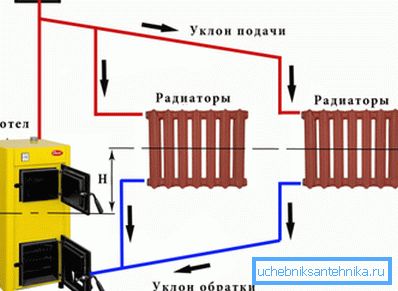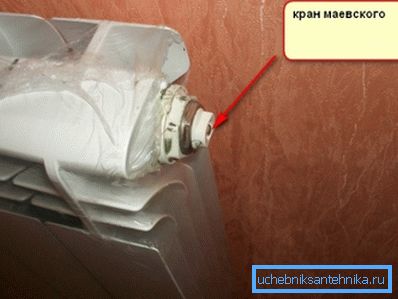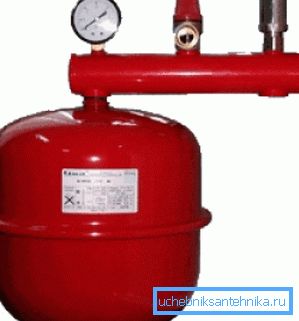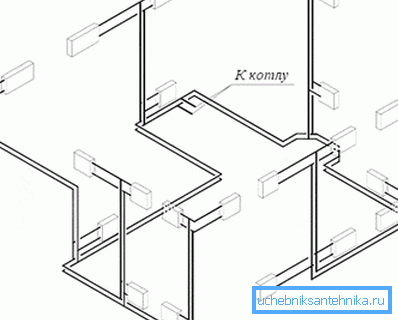The scheme of the heating system of a private house: wiring
How can be created a scheme of the heating system of a private house with your own hands? And what are the essential elements it should include? How to connect heating devices? What should be the batteries and pipes?
Let's try to answer these questions.

Gravity system
The simplest scheme of the heating system in a private house is the so-called gravitational, or gravity. It functions due to the difference in density of the heated coolant and the coolant cooled in the heaters.
Bottling
It is laid with a large (at least DN 32) diameter. The goal is to reduce the hydraulic resistance: the pressure that overcomes it in this system is small.
Pay attention: do not confuse the conditional passage of the pipe (DU) and its outer diameter, which marks the elements of polymer and metal-polymer pipelines. For example, for polypropylene DU32 corresponds to an outer diameter of 40 mm.
For the same reasons, it is better to prefer modern polymeric materials. Over time, steel is overgrown with deposits and rust, becoming more and more rough.
Immediately after the boiler, the bottling is supplied with a so-called booster pipe - a vertical section, at the top of which an open expansion tank is mounted. Further part of the filling is performed with a constant slope to the return pipe of the boiler.
The boiler, in turn, is mounted at the lower point of the contour; Often it is installed in the pit. The greater the height difference between the boiler and radiators, the greater the pressure, the faster the water will circulate in the circuit.

Distribution and connection of radiators
The optimal schemes of heating systems of private houses with natural circulation are different versions of Leningrad.
What it is?
- Filling is a continuous ring connecting the supply and return pipes of the boiler.
- Heating devices are connected in parallel with filling with a liner of a smaller diameter.
- The optimal connection scheme for heating devices is from bottom to bottom. In this case, the battery does not need to be flushed: the sludge does not linger in its lower collector.
For systems with a solid fuel boiler, it is better to prefer cast iron radiators or steel registers. Their large volume and solid mass will smooth out the fluctuations of the coolant during firing and burning of fuel.
Valves
Gravitational schemes of heating systems for a private house are completed with a minimum of valves. First, they do not need it: to eliminate leaks, it is easier to completely discharge and recharge water. Secondly, each valve or choke causes the loss of the coveted pressure and slows down the already slow circulation.
What is vital?
- Air vent in radiators located above the bottling. The air from the filling itself is forced into the expansion tank and from there into the atmosphere.

- Reset at the bottom of the circuit to drain it.
- Discharge from the cold-water system with a valve for filling the circuit through the expansion tank.
Forced circulation
The schemes of the heating system of a private house with forced circulation are more common because of the more flexible adjustment that allows you to adjust heating devices and certain parts of the circuit independently.
In addition: such a system goes faster to operating temperatures and has a smaller temperature range between flow and return.
Security
The main problem of a closed system with forced circulation is that it needs to compensate for the expansion of the coolant.
The functions of the only open expansion tank, which complement the open circuits of the heating systems of a private house with natural circulation, have to be shifted to a whole group of devices - the so-called security group.

| Device | Function |
| Expansion tank | Contains the heat carrier which has increased in volume, squeezing at the same time the air which is in its case |
| Safety valve | Relieves excess pressure when tank overflows |
| Manometer | Used to control the pressure in the system |
| Automatic air vent | Removes air plugs from the system. |
Valves
Let's find out with what kind of stop valves does the traditional heating system of a private house do it yourself?
- In front of the pump in the direction of flow of the coolant is sump.
- The pump and sump is cut off with a pair of valves, allowing them to be dismantled or the filter cleaned without loss of coolant.
- Often between bypasses of the pump, a bypass is blocked by a valve or non-return valve, allowing the system to operate when the pump is removed in natural circulation mode.
- The upper points of the circuit (jumpers, upper radiator plugs) are supplied with Mayevsky taps or ordinary water fitting taps for air exhaust.
- Feeder pipes of heating devices are equipped with valves that allow to completely stop the circulation in them. Reverse linings are throttled.
Thermal heads are often used instead of chokes: their price is somewhat higher, but they allow you to adjust the permeability automatically, depending on the temperature in the room.

By the way: for gas, electric and solar boilers, it is preferable to use aluminum radiators. They are cheap, have a small internal volume (which guarantees rapid heating) and excellent heat transfer to one section.
Layout
What schemes of installation of the heating system in a private house can be used in case of forced circulation?
- For a one-story house, in the modest opinion of the author, the same choice in Leningrad will be the best choice.. The instruction is connected with its exceptional simplicity and fault tolerance: in order to defrost this system even in the most severe cold, you need to try very hard.
- For a two-story house can be used as Leningrad with two parallel rings, and vertical wiring with bottom bottling (the return and supply are in the basement or on the first floor). Jumpers of each riser are completed with air vent.

Conclusion
We hope that the background information offered to the reader will help him in designing his own heating. The attached video, as usual, contains additional material. Successes!